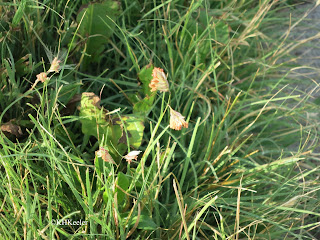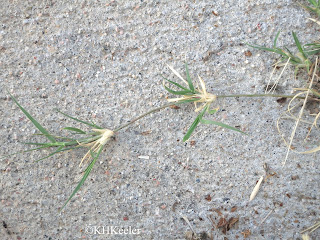buffalo grass, male flowers, sticking up
|
The success of buffalo grass is the more amazing to me because buffalo grass is dioecious. Dioecious means that there are male plants and female plants that have to mate before a seed is produced.
Let me take a step back. There's a basic division of labor in humans, dogs, cats and other familiar animals, where only half of the species become pregnant with the child (puppy, kitten...). Humans dogs and cats would be called dioecious, if that wasn't a botanical term.
In contrast, most plants have "perfect" flowers, meaning that both sexual functions--a mobile sperm and a large egg developing in a ovary (same function as animals, so same name, rather different details)--are found within the same flower. Often a genetically different individual is required as the other parent in order to produce seeds, but each plant is both father to some seeds and mother to others. This is seen as generally advantageous, since plants are immobile and cannot, like people or dogs or cats, move around looking for a mate.
 |
| female flowers of buffalo grass |
I've been paying attention to which plants are dioecious. Red cedars (Juniperus spp.), aspen and cottonwoods (Populus spp.), mulberry (Morus) and Osage orange (Maclura pomifera) are dioecious plants you might know in North America. I can, however, think of many more plants that are not dioecious from maples (Acer spp.) to oaks (Quercus spp.) to plums and cherries (Prunus spp.), American linden (Tilia americana ), redbud (Cercis canadensis ), ponderosa pine (Pinus ponderosa) not to mention roses, sumac, rhododendrons, blackberries...
Buffalo grass, Buchloë dactyloides, is native across the North American high plains, the temperate zone center of the second largest continent. Dioecy is rare on the plains, though not unknown.
So, what does being dioecious mean to buffalo grass?
Plants are male, making pollen but not seeds, or they are female, making no pollen but receiving it and making seeds.
One consequence is that this makes it hard to realize the male and female plants belong to the same species. Male plants' flowers are white- to cream-colored with red stamens poking out. (Photo at top of blog). They stand taller than the leaves. Female plants' flowers are green to yellow and are produced below the top of the leaves. It is pretty easy to see that a male plant is in flower. To see the flowers of the female you have to push apart the leaves.
(I am skipping technical terms. As you might guess, people with precise minds can point out numerous ways plants do not have the same reproductive system as animals. So, be aware that my terms are chosen to get the big ideas across and specialists will have specialized vocabulary.)
buffalo grass, male (left) and female (right) flowers. Dime for scale.
|
buffalo grass female with seed capsules
|
And what if the neighboring clone is male too?
So, I'm amazed that this little grass ever gets a sperm-carrying pollen grain to the down-in-the-grass ovule-bearing female flower.
But clearly it does. Buffalo grass was one of the most common grasses in the short grass steppe of the high plains.
I don't have the answer to this one. Being dioecious forces mating between different genetic individuals, but the vast majority of plants do just fine with perfect flowers.
buffalo grass, spreading
|
Notice that there are four seeds in a bur. The odds are 1 in 64 that all four seeds will be the same sex. So most of the time if all the seeds in the bur germinate and live, there will be potential mates. Maybe a little inbred, but during the time the bur was in the bison, the bison probably wandered yards to miles from the parent plant, so any buffalo grass neighbors are likely to be unrelated.
Buffalo grass germinates better when in the bur than if you break out the seeds and plant them individually. There aren't a lot of studies of whether seeds germinate better alone or in groups, in the pod or out of the pod. It does vary. And buffalo grass is one of the plants where the seedlings do better if they stay in the bur. Among other things, the bur holds moisture. From the point of dioecy, that keeps the seeds together, and provides those potential mates for an isolated plant.
Buffalo grass is an extremely successful, short grass that both fed the American buffalo and was distributed by them. This is the more amazing because to me buffalo grass has an odd breeding system as a dioecious clonal grass.
Comments and corrections welcomed.
buffalo grass, Buchloë dactyloides grass family, Poaceae
|
Quinn, J. A. 1987. Relationship between synaptospermy and dioecy in the life histoy strategies of Buchloë dactyloides (Gramineae). American Journal of Botany. 74 (8) 1167-1172. synaptospermy means "keeping the seeds together until germination"
Quinn, J. A. and J. L. Engel. 1988. Life-history strategies and sex ratio for a cultivar and a wild population of Buchloë dactyloides (Gramineae). American Journal of Botany. 73 (6): 874-881.
Quinn, J. A., D. P. Mowrey, S. M. Emanuele and R. D. B. Whalley. and J. L. Engel. 1994. The "Foliage is the Fruit" hypothesis: Buchloë dactyloides (Poaceae) and the shortgrass prairie of North America. American Journal of Botany. 81 (12): 1548-1554.
Kathy Keeler, A Wandering Botanist
More at awanderingbotanist.com
Join me on Facebook





The success of buffalo grass is the more amazing to me because buffalo grass is dioecious. Dioecious means that there are male plants and ... aamazinggrass.blogspot.com
ReplyDeleteThis comment has been removed by a blog administrator.
ReplyDeleteI enjoyed your discussion of dioecy in buffalo grass and its possible implications. Maybe the habitat (or the habitat in which it evolved) is open and windy enough that pollen can fly afar. BTW ... not sure why it took so long to find your blog, but I'm glad I did – I'm a wandering botanist too :)
ReplyDeleteExperimenting with planting grass seed of different varieties. This may give you a solution that is simple and inexpensive. There are many hardy seed types that can tolerate a wider variety of water and soil conditions.grass
ReplyDeleteThanks for sharing the info, keep up the good work going.... I really enjoyed exploring your site. good resource... Marijuana online
ReplyDeleteI can see that you are an expert at your field! I am launching a website soon, and your information will be very useful for me.. Thanks for all your help and wishing you all the success in your business. The Lawn Solutions
ReplyDeleteDo the runners or shoots originate from both the male and female plants, or females only? In my yard I have not noticed any males that produce the runners.
ReplyDeleteI also am amazed that a plant has two methods of reproducing. Thanks from Colorado Springs
Yes, both male and female plants expand by runners. Perhaps by luck your female plants are in better spots than the male plants.
Delete